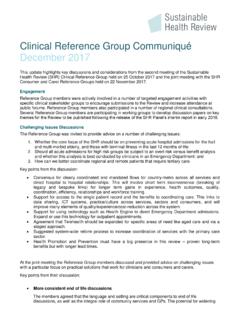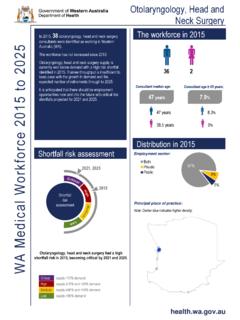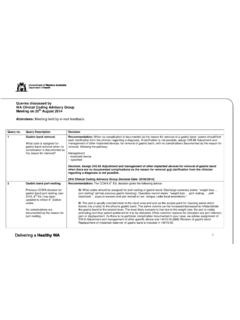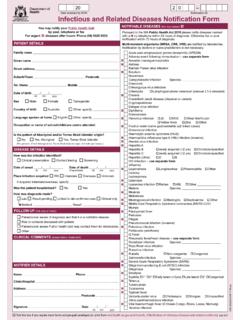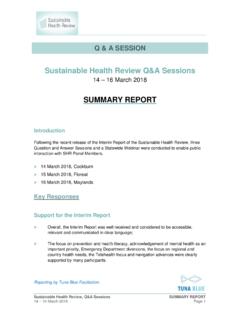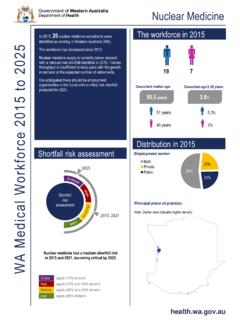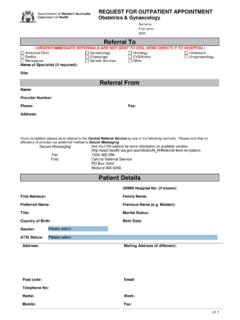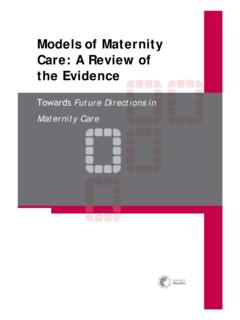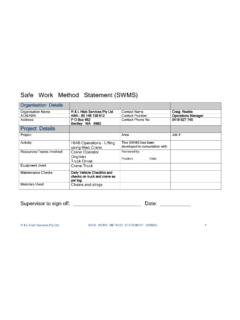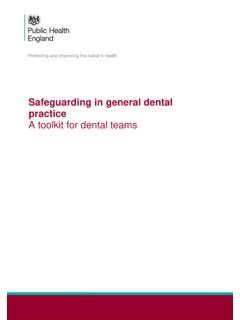Transcription of Aggressive, Offensive and Inappropriate Behaviour Management
1 Page 1 of 8 Child and Adolescent Health Service CAHS Policy Manual POLICY Aggressive, Offensive and Inappropriate Behaviour Management Scope (Staff): All Scope (Area): CAHS (Valid at PCH) Aim This policy provides direction to Child and Adolescent Health Service (CAHS) staff on how to manage aggressive, Offensive or Inappropriate Behaviour by a parent, patient, carer or visitor. Risk Breach of legislative requirements including Duty of Care responsibilities under the WA Occupational Safety and Health Act 19841 and WA OSH Regulations 19962. There is an increased risk of employee injury and illness if OSH prevention Management is not followed. Definitions bullying : overt bullying examples can include: abusive, insulting or Offensive language, Behaviour or language that frightens, humiliates, belittles or degrades, including criticism that is delivered with yelling and screaming.
2 Inappropriate Behaviour : Behaviour that is considered aggressive, Offensive , or threatening, verbally or physically, to another person. Non-physical violence : verbal abuse, intimidating and threatening Behaviour and postures, may also significantly affect a person s health and wellbeing. Threats may be perceived or real and there does not have to be physical injury for the violence to be a workplace hazard. Employees may be affected by non-physical workplace violence even if they are not directly Physical violence : the use of physical force against another person or group that may result in physical or psychological harm. It includes, but is not limited to, punching, pinching, biting, pushing, spitting, slapping, kicking, beating, shooting and stabbing. This can also include ignoring staff members or refusing to acknowledge Psychological violence /Threat: the use of power against another person or group that may result in psychological harm.
3 This includes, but is not limited to, verbal abuse, suggestive Behaviour , belittlement, threats of physical abuse, intimidation and bullying . Risk of intimidation to staff by clients through the use of cyber Visitor: a person visiting the hospital/workplace- Parent, carer, relative, or other. Workplace aggressive Behaviour : incidents, perceived or real to individuals, when they are abused, threatened or assaulted in circumstances arising out of, or in the course of their employment, involving an explicit or implicit challenge to their safety, health or Aggressive, Offensive and Inappropriate Behaviour Management Page 2 of 8 Workplace violence : an action or incident that physically or psychologically harms another person. It includes situations where employees and other people are threatened, attacked or physically assaulted at Zero Tolerance: a complete refusal to tolerate aggressive Principles CAHS will provide and maintain a safe work environment in order to prevent workplace aggression and violence and complies with the WA Department of Health (DOH) Prevention of Workplace violence and aggression Policy and Guidelines and WA Health Preventing and Responding to Workplace bullying Policy.
4 All Staff must comply with the Local Management Process for their relevant area as outlined in Appendix 1. Employees have the right to work in an environment free from aggressive Behaviour and violence . 4 Patients and visitors have the right to visit or receive health care, in a therapeutic environment free from risks to their personal Reporting All incidents involving aggressive, Offensive and Inappropriate Behaviour must be reported via the relevant channel and documented accordingly. Incidents involving patient/clients must be documented in the medical/health record. o Datix CIMS to be completed for clinical incidents where health care could have or did lead to unintended and/or unnecessary harm to a patient/ o OSH Incident Form - to be completed by employees immediately following an incident or identification of a workplace hazard, including violence .
5 O Security Incident Form code Black Personal Threat Offender ID Form to be completed for incidents where staff are subject to aggressive, Offensive and Inappropriate Behaviour by patients/clients and/or visitors. Refer to code Black - Personal Threat. Roles and Responsibilities CAHS Executive/Executive Directors CAHS Executive/Executive Directors are responsible for: o the occupational safety and health of all CAHS employees o supporting and facilitating a safe work environment. Manager / Supervisor All Managers and supervisors are responsible for: o implementing and maintaining a safe work place and work practices including environmental and hazard Management Aggressive, Offensive and Inappropriate Behaviour Management Page 3 of 8 o ensuring all staff comply with mandatory training requirements o completing OSH investigations, action planning, and feed back to affected employees, in regards to reported hazards and incidents o complying CAHS, OSH and site policies o promoting a workplace free of aggressive Behaviour and violence o Management of incidents involving aggressive Behaviour and violence by a parent, patient, carer or visitor.
6 Employee All CAHS employees are responsible for: o protecting their own safety and health and that of others at work by following relevant OSH instructions o reporting hazards and incidents to relevant line manager immediately o cooperating with CAHS on safety and health issues. Visitors & Volunteers All CAHS volunteers and visitors are responsible for: o treating staff with respect and dignity o cooperating with CAHS policies and procedures as instructed by staff. OSH Department The OSH Department is responsible for: o providing consultation and advice on OSH issues o providing assistance with worksite review when required o providing assistance with risk assessments when required. OSH Prevention Management System All Staff must comply with OSH Prevention Management System. System Context Potential Mechanisms People Face-to-face communication Phone call communication Clients with licit or illicit substances Staff training Client cohort checking of alert information systems Aggressive, Offensive and Inappropriate Behaviour Management Page 4 of 8 Environment Interview / consulting rooms Mental health facilities Emergency Department + Home visit Crime Prevention Through Environmental Design (CPTED) incorporated resources Access to entry/exit door of interview room kept clear Consider dual egress in interview room for CAMHS sites Staff areas located separate to client areas as far as practicable Safe refuge area available ( nurses station)
7 Increased visibility and good lighting Waiting areas to be comfortable and spacious Clear path to popular common-use fittings ( water dispensers) and work environment Home visiting policy Equipment What equipment is in place Duress alarms: personal or hardwired CCTV Furniture arranged to allow for staff to have unobstructed access to door and client to have easy access to leave room Client access to equipment that can be used as a potential weapon to be minimised Wide counters and reception barriers considered depending on risk assessment of the area Secured fixtures and accessories clocks, art work Furniture minimised but sufficiently robust Policy and procedures What procedures Clinical review prior to acceptance of the patient CRAM/ client risk Assessments completed Treatment / Management plan, including specific triggers and de-escalation strategies Policies and procedures including client restraint code Black response procedure code Black drills Aggressive.
8 Offensive and Inappropriate Behaviour Management Page 5 of 8 Critical and Clinical Event Debrief Policy Written duress response procedures ISOBAR process Home visiting procedures Organisation Staffing numbers and skill mix appropriate for client /patient cohort Patient/Clients serviced in appropriate clinical work areas Patient/Clients serviced within defined catchment areas that reflect team size. Adequate staffing levels Staff working together when a risk is identified with staff member working alone Clear communication aggression prevention posters Employees and casual staff appropriately trained and inducted to site Management of aggression training Therapeutic Crisis Intervention training Workplace Hazard Inspections Workplace aggression audits conducted Facilities reviewed and updated for staff and client safety Security personnel assistance as required requested via manager of service Development of relationships and protocols with local police/external stakeholders Employee Incident/Hazard report forms and Security reports reviewed for trends and preventive measures Related internal policies, procedures and guidelines Incident and Hazard Reporting (CAHS OSH Policy) Occupational Health and Safety (CAHS OSH Policy)
9 Clinical Incident Management (CAHS Policy) Critical and Clinical Event Debrief (CAHS Policy) Aggressive, Offensive and Inappropriate Behaviour Management Page 6 of 8 code Black - Personal Threat (CAHS Policy) Critical Incident Stress Management for Staff (CACH Procedure) References 1. WA Occupational Safety and Health Act 1984 2. WA Occupational Safety and Health Regulations 1996 3. WA code of Practice violence , aggression And bullying at Work 2010 4. WA Health Preventing and Responding to Workplace bullying Policy 5. CAHS Clinical Incident Management Policy Useful resources (including related forms) CAHS OSH Incident Form WA Mental Health Act 2014 WA Criminal code Act Compilation Act 1913 WA Health Employee Grievance Resolution Policy WA DOH Clinical Incident Management Australian Risk Services ICAM Training This document can be made available in alternative formats on request for a person with a disability.
10 File Path: W:\Safety & Quality\CAHS\Policy\POLICY Management - Area Health Service\CAHS Policy\_Word\ Document Owner: Executive Director, Workforce Reviewer / Team: CAHS Workforce Services Date First Issued: September 2012 Last Reviewed: January 2018 Review Date: January 2019 Approved by: Corporate Governance Committee Date: January 2018 Endorsed by: Executive Director, Corporate Services Date: January 2018 Standards Applicable: NSQHS Standards: NSMHS: 2,8 Printed or personally saved electronic copies of this document are considered uncontrolled Aggressive, Offensive and Inappropriate Behaviour Management Page 7 of 8 Appendix 1: Local Management Process Pathways PMH/PCH Inpatient Setting, CACH and CAMHS Management Pathway Person identifying Behaviour will inform the person/s that they are in breach of acceptable Behaviour and that this Behaviour is to cease as you feel unsafe/intimidated/threatened and will leave if the Behaviour continues.
